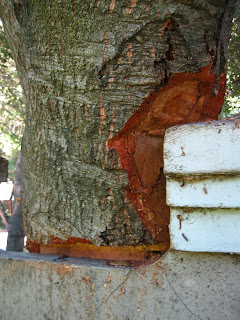Does-It-Himself Greg in San Carlos took a break from remodeling his home to write:
"Here's the problem: I'm a cheap bastard. More specifically, I like a nice yard with blooming vines, healthy hydrangeas and lush, jungle-green ferns. And if there's any way I can plant them and care for them myself, I will.
"After our remodel we're going to need to do some substantial landscaping to the front and back. Me being me, I'm thinking I can do it myself. With that in mind, I have dug up and saved hydrangeas and ferns and roses that had been in the line of fire, and I even had the crew dig up and replant a very mature camilia (so far, so good). The crew also cleared out a rotting hot tub and old deck so that we will have much more room in the backyard, where I'd like to put in a small lawn and use plants that thrive under two large Monterey pines.
"So my question is, what the hell do I do now? Am I in way over my head? Which aspects of he project should I pay the pros to do, and which could I realistically do myself?"
Greg, your, um,
frugality means you need to work extra hard to define two things: (1) your budget, and (2) your priorities. On the first count, you've got to do your homework and figure out exactly how cheap you really are. How much can you spend without losing sleep over it? Remember that remodels have a funny way of costing a bit more than expected; do you want to sock any money away in a special "landscaping" bank account before it's all spent? Don't worry right now
how the money will be used—just be honest, pick a finite number, and make it inviolable. (Hint: involve your wife in this exercise.)
On the second count, take stock of what will really bring joy to you and your family. How much lawn will you and your kids really use? Will you need a spot to grill steaks? A shady place to sit and relax while the kids romp? I'm guessing you're the gardener—how much time will you really have each week to keep the yard looking its best? What yard chores will you enjoy, or dread? Is it important to you that your yard look "mature" soon, or can you wait a few years for things to fill in? Make a list of every quality you'll want. Dream out loud. (Hint: involve your wife in this exercise.) Then rank them from highest priority ("absolutely must have") to lowest ("icing on the cake"). This will tell you where your finite number, see above, should be spent.
But let's back up a step or two, Greg. I get that you're, um,
economical. My dad was, um,
thrifty too: he'd drive across town to fill up at the gas station that was 2 cents cheaper than the others. But what did he actually save? Nothing. Worst of all, he didn't take any real joy in the process or pride in the outcome. So back to you: what's your aversion to hiring a pro to come up with something that's beautiful, within your budget, and facilitates the life you want to live?
Of course you
could do it yourself. You could glean tips from garden design books and blogs, copy planting plans from magazines, learn how to design and install irrigation and lighting systems, rent a pickup and a Ditch Witch and a Rototiller, lay your own sod and install your own shrubs. It's not quite rocket science, even the irrigation part, and if you're really a cheapskate, you
can do all of this. You'll save a bunch of money. But you'll also be out a bunch of time — time with your wife who adores you, your sons who revere you, your friends who enjoy you, your avocations which enrich you, and probably even your work — which presumably affords you the possibility of not having to spend all your free time on this.
So that's where I would draw the line: What aspects of the project would you truly enjoy? If you aspire to design green spaces, if you love learning about plants and experimenting with what you've learned, then take that on. If you love getting your hands dirty and putting small parts together to create complex yet rational systems, then take on the irrigation/lighting installation. If you love getting your hands
really dirty while getting a fair amount of exercise, then take on the soil work and planting.
Take on what you'll love… and hire a pro for the rest of it. The money you spend will come back to you in well-designed spaces that enhance your precious time with your family; in well-selected and well-installed plants that thrive under those pines; and in well-designed systems that perform efficiently every day.
I feel like we're just getting started, so tell you what: in a couple of posts, I'll write about
how you can keep your costs down when you
do choose to hire a pro. Just remember: my advice is worth exactly what you pay for it.
 Up north, we can't grow Jacaranda mimosifolia very successfully due to our typically frosty and occasionally freezing winters. Down here, the tree's vibrant lavender blooms are pretty much ubiquitous this time of year.
Up north, we can't grow Jacaranda mimosifolia very successfully due to our typically frosty and occasionally freezing winters. Down here, the tree's vibrant lavender blooms are pretty much ubiquitous this time of year.

